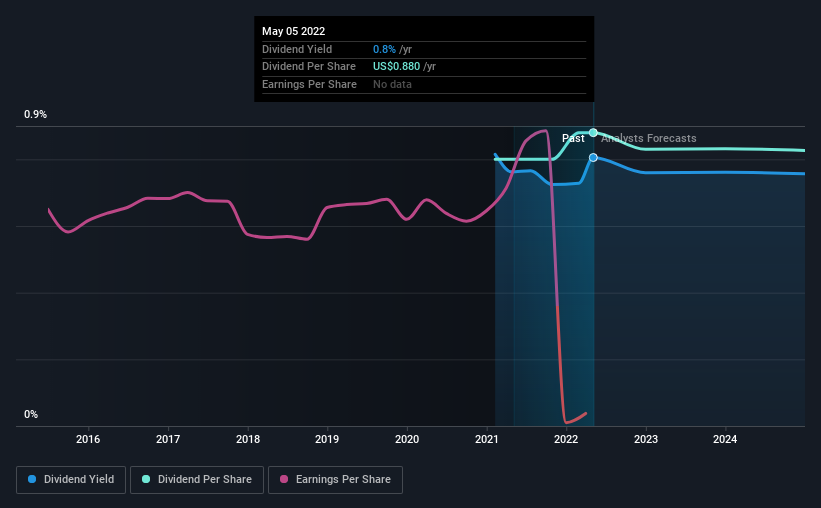Dividend Investors: Don't Be Too Quick To Buy Crown Holdings, Inc. (NYSE:CCK) For Its Upcoming Dividend
Some investors rely on dividends for growing their wealth, and if you're one of those dividend sleuths, you might be intrigued to know that Crown Holdings, Inc. (NYSE:CCK) is about to go ex-dividend in just four days. The ex-dividend date is one business day before the record date, which is the cut-off date for shareholders to be present on the company's books to be eligible for a dividend payment. The ex-dividend date is an important date to be aware of as any purchase of the stock made on or after this date might mean a late settlement that doesn't show on the record date. Accordingly, Crown Holdings investors that purchase the stock on or after the 11th of May will not receive the dividend, which will be paid on the 26th of May.
The company's upcoming dividend is US$0.22 a share, following on from the last 12 months, when the company distributed a total of US$0.88 per share to shareholders. Calculating the last year's worth of payments shows that Crown Holdings has a trailing yield of 0.8% on the current share price of $109.26. We love seeing companies pay a dividend, but it's also important to be sure that laying the golden eggs isn't going to kill our golden goose! As a result, readers should always check whether Crown Holdings has been able to grow its dividends, or if the dividend might be cut.
Check out our latest analysis for Crown Holdings
Dividends are typically paid from company earnings. If a company pays more in dividends than it earned in profit, then the dividend could be unsustainable. Crown Holdings paid a dividend last year despite being unprofitable. This might be a one-off event, but it's not a sustainable state of affairs in the long run. Given that the company reported a loss last year, we now need to see if it generated enough free cash flow to fund the dividend. If cash earnings don't cover the dividend, the company would have to pay dividends out of cash in the bank, or by borrowing money, neither of which is long-term sustainable. Dividends consumed 55% of the company's free cash flow last year, which is within a normal range for most dividend-paying organisations.
Click here to see the company's payout ratio, plus analyst estimates of its future dividends.
Have Earnings And Dividends Been Growing?
When earnings decline, dividend companies become much harder to analyse and own safely. Investors love dividends, so if earnings fall and the dividend is reduced, expect a stock to be sold off heavily at the same time. Crown Holdings was unprofitable last year and, unfortunately, the general trend suggests its earnings have been in decline over the last five years, making us wonder if the dividend is sustainable at all.
Given that Crown Holdings has only been paying a dividend for a year, there's not much of a past history to draw insight from.
Get our latest analysis on Crown Holdings's balance sheet health here.
Final Takeaway
From a dividend perspective, should investors buy or avoid Crown Holdings? We're a bit uncomfortable with it paying a dividend while being loss-making. However, we note that the dividend was covered by cash flow. It's not an attractive combination from a dividend perspective, and we're inclined to pass on this one for the time being.
With that being said, if you're still considering Crown Holdings as an investment, you'll find it beneficial to know what risks this stock is facing. We've identified 2 warning signs with Crown Holdings (at least 1 which can't be ignored), and understanding them should be part of your investment process.
A common investing mistake is buying the first interesting stock you see. Here you can find a full list of high-yield dividend stocks.
Have feedback on this article? Concerned about the content? Get in touch with us directly. Alternatively, email editorial-team (at) simplywallst.com.
This article by Simply Wall St is general in nature. We provide commentary based on historical data and analyst forecasts only using an unbiased methodology and our articles are not intended to be financial advice. It does not constitute a recommendation to buy or sell any stock, and does not take account of your objectives, or your financial situation. We aim to bring you long-term focused analysis driven by fundamental data. Note that our analysis may not factor in the latest price-sensitive company announcements or qualitative material. Simply Wall St has no position in any stocks mentioned.

 Yahoo Finance
Yahoo Finance 
